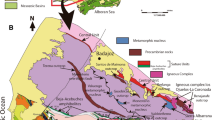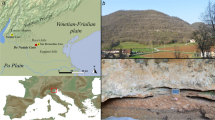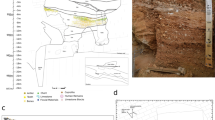Abstract
The appearance of Upper Paleolithic techniques of blade production is the key signal of Initial Upper Paleolithic (IUP) industries throughout Eurasia and, particularly, in Central Asia. Here, we present the results of a detailed reconstruction of the principal knapping method targeting blade production at the Ushbulak site in eastern Kazakhstan that currently marks the southwestern extent of the distribution of Asian IUP industries. Based on the typology of IUP cores at Ushbulak, we carried out experimental blade production using three main knapping methods that have been described in IUP complexes across northern Eurasia. Each technique was applied to the production of blades and core management elements morphologically similar to artifacts from the Ushbulak assemblage. Experimental approaches and attribute analysis established the dominance of the sub-prismatic bidirectional laminar method, based on well-prepared pre-core knapping. The reconstructed bidirectional method for blade production reflects traits in common with Moravian Bohunician IUP complexes, but the closest analogies can be found in IUP complexes of the Russian Altai Region (Kara Bom) and Mongolia (Tolbor 4). The most pronounced traits distinguishing the Ushbulak IUP industries from those of neighboring regions are the dominance of only one method of bidirectional blade production and the absence of Levallois technology. No changes in primary knapping methods and tool assemblages were revealed in Ushbulak IUP complexes over a period of roughly 10,000 years. This industry first appeared in its complete form in eastern Kazakhstan ca. 49–47 ka and existed without detectable changes until its disappearance ca. 37–35 ka.










Similar content being viewed by others
Notes
Most blocks were discarded after initial knapping because of internal flaws and other imperfections in the raw material.
References
Anoikin AA, Pavlenok GD, Kharevich VM et al (2019) Ushbulak — a new stratified upper paleolithic site in northeastern Kazakhstan. Archaeol Ethnol Anthropol Eurasia 47:16–29. https://doi.org/10.17746/1563-0102.2019.47.4.016-029
Anoikin AA, Zotkina LV, Kharevich VM, Pavlenok GD (2021) The non-utilitarian objects from the initial upper Paleolithic Ushbulak site in eastern Kazakhstan. Archaeol Res Asia 25:100261. https://doi.org/10.1016/j.ara.2021.100261
Belousova NE, Rybin EP, Fedorchenko AY (2019) Treatment strategy of stone raw material in the Initial Upper Palaeolithic of Gorny Altai (based on materials of cultural horizon UP2, Kara-Bom site). Strat plus 1:225–250
Brantingham PJ, Krivoshapkin AI, Jinzeng L, Tserendagva Y (2001) The Initial Upper Paleolithic in Northeast Asia. Curr Anthropol 42:735–747. https://doi.org/10.1086/323817
Cohan J (1988) Statistical power analysis for the behavioral sciences. Lawrence Erlbaum Associates, New Jersey
Damlien H (2015) Striking a difference? The effect of knapping techniques on blade attributes. J Archaeol Sci 63:122–135. https://doi.org/10.1016/j.jas.2015.08.020
Derevianko AP (2001) Middle to Upper Paleolithic transition in Altay. Archaeol Ethnol Anthropol Eurasia 3:70–103
Derevianko AP, Petrin VT, Rybin EP, Chevalkov LM (1998) Paleolithic complexes of the stratified part of the Kara-Bom site (Mousterian/Upper Paleolithic). IAET SB RAS Publ, Novosibirsk
Derevianko AP, Zenin AN, Rybin EP et al (2007) The technology of early Upper Paleolithic lithic reduction in Northern Mongolia: the Tolbor-4 site. Archaeol Ethnol Anthropol Eurasia 29:16–38. https://doi.org/10.1134/S1563011007010021
Derevianko AP, Rybin EP, Gladyshev SA et al (2013) Early Upper Paleolithic stone tool technologies of Northern Mongolia: the case of Tolbor-4 and Tolbor-15*. Archaeol Ethnol Anthropol Eurasia 41:21–37. https://doi.org/10.1016/j.aeae.2014.07.004
Goebel T, Derevianko AP, Petrin VT (1993) Dating the Middle-to-Upper-Paleolithic transition at Kara-Bom. Curr Anthropol 34:452–458. https://doi.org/10.1086/204192
Hammer Ø, Harper DAT, Ryan PD (2001) Past: paleontological statistics software package for education and data analysis. Palaeontol Electron 4:1–9
Hublin JJ, Sirakov N, Aldeias V et al (2020) Initial Upper Palaeolithic Homo sapiens from Bacho Kiro Cave, Bulgaria. Nature 581:299–302. https://doi.org/10.1038/s41586-020-2259-z
Inizan M, Ballinger M, Roche H, Tixier J (1999) Technology and terminology of knapped stone. C.R.E.P., Nanterre
Kadowaki S, Tamura T, Kida R et al (2022) Lithic technology and chronology of Initial Upper Paleolithic assemblages at Tor Fawaz. Springer International Publishing, Southern Jordan
Kharevich VM, Zotkina LV, Anoikin AA, Taimagambetov ZK (2020) Auxiliary knapping tools in the Initial Upper Palaeolithic stone assemblages (with particular reference to the materials of the Ushbulak site). Strat plus 1:239–256
Koropetskyi R, Stepanchuk V, Škrdla P et al (2021) Radiocarbon dating the Initial Upper Paleolithic on the East European Plain at Kulychivka (Western Ukraine). J Paleolit Archaeol. https://doi.org/10.1007/s41982-021-00082-9
Kuhn SL, Zwyns N (2014) Rethinking the initial Upper Paleolithic. Quat Int 347:29–38. https://doi.org/10.1016/j.quaint.2014.05.040
Kurbanov RN, Ulyanov VA, Anoikin AA et al (2021) The first luminescence chronology of the Initial Upper Paleolithic of Eastern Kazakhstan (case study of the Ushbulak archaeological site). Moscow Univ Bull 1:97–113
Lund RE, Lund JR (1983) Algorithm AS 190: probabilities and upper quantiles for the studentized range. J R Stat Soc 32:204–210
Marks AE, Volkman P (1983) Changing core reduction strategies: a technological shift from middle to the Upper Paleolithic in the Southern Levant. In: Trinkhaus E (ed) The Mousterian Legacy: human biocultural change in the upper Pleistocene. BAR International Series, Oxford, pp 13–33
Meignen L (2012) Levantine perspectives on the Middle to upper Paleolithic “transition.” Archaeol Ethnol Anthropol Eurasia 4:12–21
Nehoroshev VP (ed) (1971) Geology of the USSR. Nedra Press, Moscow
Neruda P, Nerudová Z (2013) The Middle-Upper Palaeolithic transition in Moravia in the context of the Middle Danube region. Quat Int 294:3–19. https://doi.org/10.1016/j.quaint.2011.08.035
Rybin EP (2014) Tools, beads, and migrations: specific cultural traits in the Initial Upper Paleolithic of Southern Siberia and Central Asia. Quat Int 347:39–52. https://doi.org/10.1016/j.quaint.2014.04.031
Rybin EP, Khatsenovich AM (2020) Middle and Upper Paleolithic Levallois technology in eastern Central Asia. Quat Int 535:117–138. https://doi.org/10.1016/j.quaint.2018.10.042
Rybin EP, Khatsenovich AM, Marchenko DV (2019) Model of technological development in the industries of early stages of the Upper Paleolithic in Northern Mongolia: according to the results of new excavations of the Tolbor-4 site. Teor Prakt Arkheol Issled 28:164–179. https://doi.org/10.14258/tpai(2019)4(28).-12
Rybin EP, Shelepaev RA, Popov AY et al (2018) Sedimentary rocks exploitation in Upper Paleolithic knapping technology in the territory of Central Asia and South Siberia. Teor i Prakt arkheologicheskikh Issled 146–156. https://doi.org/10.14258/tpai(2018)2(22).-09
Rybin EP (2020) Regional variability of the lithic assemblages in the beginning of the Upper Paleolithic in Southern Siberia and Eastern part of Central Asia. The thesis for the degree of Doctor of Historical Sciences, Novosibirsk
Shunkov M, Anoikin A, Taimagambetov Z et al (2017) Ushbulak-1: new Initial Upper Palaeolithic evidence from Central Asia. Antiquity 91:1–7. https://doi.org/10.15184/aqy.2017.208
Shunkov M, Anoikin A, Pavlenok G et al (2019) Nouveau site Paléolithique supérieur ancient au nord de l’Asie Centrale. L’anthropologie 123:438–451
Skrdla P (2003a) Comparison of Boker Tachtit and Stránská skála MP/UP transitional industries. J Isr Prehist Soc 33:37–73
Skrdla P (2003) Bohunician technjlogy: refiting approach. In: Svoboda J, Bar-Yosef O (eds) Stranska Skala. Origin of the Upper Paleolithic in the Brno Basin, Moravia, Czech Republic. Peabody Museum Press, Harvard, pp 119–152
Skrdla P (2013) The Bohunician in Moravia and adjoining regions. Archaeol Ethnol Anthropol Eurasia 41:2–13
Škrdla P (2017) Middle to Upper Paleolithic transition in Moravia: new sites, new dates, new ideas. Quat Int 450:116–125. https://doi.org/10.1016/j.quaint.2016.07.029
Slavinskiy V, Rybin E (2015) Prismatic technology of the stone splitting in the Early Upper Paleolithic in Altai. Izv Altai State Univ. https://doi.org/10.14258/izvasu(2015)3.2-35
Slavinsky VS, Rybin EP, Belousova NE (2016) Variation in Middle and Upper Paleolithic techniques of lithic reduction at Kara-Bom, The Altai Mountains: Refitting Studies. Archaeol Ethnol Anthropol Eurasia 44:39–50. https://doi.org/10.17746/1563-0102.2016.44.1.039-050
Slavinsky VS, Rybin EP, Belousova NE et al (2017) Specific technique of core platform preparation in the Initial Upper Palaeolithic of South Siberia and Central Asia. Strat plus 1:221–224
Svoboda J (2001) On the Middle to Upper Paleolithic transition in North Eurasia. Archaeol Ethnol Anthropol Eurasia 4:30–37
Svoboda J, Skrdla P (1995) Bohunician technology. In: Dibble HL, Bar-Yosef O (eds) The definition and interpretation of Levallois technology. Madison, Wisconsin, pp 429–438
Tostevin GB (2003) Atribute analysis of the lithic tehnologiesn of Stranska Skala IIIc and IIId in regional and Interregional context. In: Svoboda J, Bar-Yosef O (eds) Stranska Skala. Origin of the Upper Paleolithic in the Brno Basin, Moravia, Czech Republic: Origins of the Upper Paleolithic in the Brno Basin, Moravia, Czech Republic. Peabody Museum Press, Harvard, pp 77–118
Tostevin GB (2017) A quest for antecedents. More than meets the eye. Oxbow Books, Oxford, pp 54–67
Usik VI (1989) Korolevo - Transition from lower to upper palaeolithic according to reconstruction data. Antropologie (2-3):179-212
Valoch K, Neruda P, Nerudová Z (2009) The Bohunician technology from the Stránská skála open-air site (the Czech Republic). In: Burdukiewicz J, Cyrek K, Dyczek P, Szymczak K (eds) Understanding the past. Papers offered to Stefan K. University of Warsaw, Warszawa, Kozłowski, pp 387–404
Zwyns N (2021) The Initial Upper Paleolithic in Central and East Asia: blade technology, cultural transmission, and implications for human dispersals. J Paleolit Archaeol 4:19. https://doi.org/10.1007/s41982-021-00085-6
Zwyns N, Paine CH, Tsedendorj B et al (2019) The Northern route for human dispersal in Central and Northeast Asia: new evidence from the site of Tolbor-16, Mongolia. Sci Rep 9:1–11. https://doi.org/10.1038/s41598-019-47972-1
Acknowledgements
The authors appreciate feedback provided by K.A. Kolobova and A.M. Khatsenovich on our results and discussion.
Funding
Archaeological investigations were supported by the Russian Science Foundation (Project No.19–18-00198) “The formation of Initial Upper Paleolithic culture in eastern Central Asia and South Siberia: polycentrism or transfer of cultural traditions along the northern route of Homo sapiens dispersal in Asia”. Analysis of experimental studies was supported by the Russian Science Foundation Project (Project No. 21–78-10146) “The Upper Paleolithic mosaic—cultural and technological lithic industry variability in the piedmont regions of northern Central Asia in the second half of the Late Pleistocene.”
Author information
Authors and Affiliations
Corresponding author
Ethics declarations
Conflict of interest
The authors have no any competing Interests in this research.
Additional information
Publisher's note
Springer Nature remains neutral with regard to jurisdictional claims in published maps and institutional affiliations.
Rights and permissions
Springer Nature or its licensor holds exclusive rights to this article under a publishing agreement with the author(s) or other rightsholder(s); author self-archiving of the accepted manuscript version of this article is solely governed by the terms of such publishing agreement and applicable law.
About this article
Cite this article
Kharevich, V., Kharevich, A., Pavlenok, G. et al. Ten millennia without the Levallois technique: primary knapping methods in Initial Upper Paleolithic industries at the Ushbulak site, eastern Kazakhstan. Archaeol Anthropol Sci 14, 207 (2022). https://doi.org/10.1007/s12520-022-01672-6
Received:
Accepted:
Published:
DOI: https://doi.org/10.1007/s12520-022-01672-6




